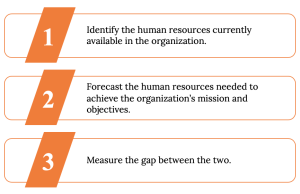10.2 Human Resource Management
Adapted by Stephen Skripak with Ron Poff
Employees at Starbucks are vital to the company’s success. They are its public face, and every dollar of sales passes through their hands.[1] They can make or break the company. If a customer has a positive interaction with an employee, the customer will come back. If an encounter is negative, the customer is probably gone for good. That’s why it’s crucial for Starbucks to recruit and hire the right people, train them properly, provide a motivating environment, and encourage them to stay with the company. Thus, the company works to provide satisfying jobs, a positive work environment, appropriate work schedules, and fair compensation and benefits. These activities are part of Starbucks’s strategy to deploy human resources in order to gain competitive advantage. The process is called human resource management (HRM), which consists of all actions that an organization takes to attract, develop, and retain quality employees. Each of these activities is complex. Attracting talented employees involves the recruitment of qualified candidates and the selection of those who best fit the organization’s needs. Development encompasses both new-employee orientation and the training and development of current workers. Retaining good employees means motivating them to excel, appraising their performance, compensating them appropriately, and doing what’s possible to keep them.

Human Resource Planning
How does Starbucks make sure that its worldwide retail locations are staffed with just the right number of committed employees? How does Norwegian Cruise Lines make certain that when the Norwegian Dawn pulls out of New York harbor, it has a complete, fully trained crew on board to feed, entertain, and care for its passengers? Managing these tasks is a matter of strategic human resource planning—the process of developing a plan for satisfying an organization’s human resources (HR) needs.
A strategic HR plan lays out the steps that an organization will take to ensure that it has the right number of employees with the right skills in the right places at the right times. HR managers begin by analyzing the company’s mission, objectives, and strategies. Starbucks’s objectives, for example, include “Creating a culture of warmth and belonging, where everyone is welcome” as well as fostering an environment in which employees treat both customers and each other with dignity and respect.[2] Thus, the firm’s HR managers look for people who are “adaptable, self-motivated, passionate, creative team members.”[3] The main goal of Norwegian Cruise Lines—to lavish passengers with personal attention—determines not only the type of employee desired (one with exceptionally good customer-relation skills and a strong work ethic) but also the number needed (one for every two passengers on the Norwegian Dawn).[4]
Job Analysis
To develop an HR plan, HR managers must be knowledgeable about the jobs that the organization needs performed. They organize information about a given job by performing a job analysis to identify the tasks, responsibilities, and skills that it entails, as well as the knowledge and abilities needed to perform it. Managers also use the information collected for the job analysis to prepare two documents:
- A job description, which lists the duties and responsibilities of a position
- A job specification, which lists the qualifications—skills, knowledge, and abilities—needed to perform the job
HR Supply and Demand Forecasting
Once they’ve analyzed the jobs within the organization, HR managers must forecast future hiring or job elimination needs (e.g. firings). This is the three-step process summarized below.

Starbucks, for instance, might find that it needs 300 new employees to work at stores scheduled to open in the next few months. Disney might determine that it needs 2,000 new cast members to handle an anticipated surge in visitors. Virgin Voyages might be short two dozen restaurant workers on one of its ships because of an unexpected increase in reservations.
After calculating the disparity between supply and future demand, HR managers must draw up plans for bringing the two numbers into balance. If the demand for labor is going to outstrip the supply, they may hire more workers, encourage current workers to put in extra hours, subcontract work to other suppliers, or introduce labor-saving initiatives. If the supply is greater than the demand, they may deal with overstaffing by not replacing workers who leave, encouraging early retirements, eliminating positions, or terminating employment.
Recruiting Qualified Employees
Armed with information on the number of new employees to be hired and the types of positions to be filled, the HR manager then develops a strategy for recruiting potential employees. Recruiting is the process of identifying suitable candidates and encouraging them to apply for openings in the organization.
Before going any further, we should point out that in recruiting and hiring, managers must comply with antidiscrimination laws; violations can have legal consequences. Discrimination occurs when a person is treated unfairly on the basis of a characteristic unrelated to ability. Under federal law, it’s illegal to discriminate in recruiting and hiring on the basis of race, color, religion, sex, national origin, age, or disability. (The same rules apply to other employment activities, such as promoting, compensating, and terminating employees.)[5] The Equal Employment Opportunity Commission (EEOC) enforces a number of federal employment laws, including the following:
- Title VII of the Civil Rights Act of 1964, which prohibits employment discrimination based on race, color, religion, sex, or national origin. Sexual harassment is also a violation of Title VII.
- The Equal Pay Act of 1963, which protects both women and men who do substantially equal work from sex-based pay discrimination.
- The Age Discrimination in Employment Act of 1964, which protects individuals who are forty or older.
- Title I and Title V of the Americans with Disabilities Act of 1990, which prohibits employment discrimination against individuals with disabilities.[6]
In June 2020, the US Supreme Court, with a 6-3 decision, ruled that discrimination based on sex, should be understood to include sexual orientation and gender identity. This ruling provided the EEOC with additional enforcement under Title VII of the Civil Rights Act of 1964.[7]
Where to find candidates
The first step in recruiting is to find qualified candidates. Where do you look for them, and how do you decide whether they’re qualified? Companies must assess not only the ability of a candidate to perform the duties of a job, but also whether he or she is a good “fit” for the company—i.e., how well the candidate’s values and interpersonal style match the company’s values and culture.
Internal versus external recruiting
Where do you find people who satisfy so many criteria? Basically, you can look in two places: inside and outside your own organization. Both options have pluses and minuses. Hiring internally sends a positive signal to employees that they can move up in the company—a strong motivation tool and a reward for good performance. In addition, because an internal candidate is a known quantity, it’s easier to predict his or her success in a new position. Finally, it’s cheaper to recruit internally. On the other hand, the company will probably have to fill the promoted employee’s position. Going outside gives the hiring manager an opportunity to bring fresh ideas and skills into the company. In any case, it’s often the only alternative, especially if no one inside the company has just the right combination of skills and experiences. Entry-level jobs are usually filled from the outside.
How to find candidates
Searching for new employees means publicizing the position. If looking internally in a small organization, employees can be alerted informally. In larger organizations, HR managers generally post openings on the internal corporate website or seek direct recommendations from various supervisors.
Recruiting people from outside is more complicated. Like marketing a product to buyers, the company promotes the virtues of working for the organization. Starbucks uses the following outlets to advertise openings:
- A dedicated section of the corporate web site (“Job Center,” which lists openings, provides information about the Starbucks experience, and facilitates the submission of online applications)
- College campus recruiting (holding on-campus interviews and information sessions and participating in career fairs)
- Internships designed to identify future talent among college students
- Announcements on employment web sites like Monster.com, Vault.com, Glassdoor.com, and SimplyHired.com
- Newspaper classified ads
- Facebook and Twitter
- Local job fairs
- In-store recruiting posters
- Informative “business cards” for distribution to customers[8]
Everything Starbucks does as a company bears on its ability to attract talent. Accordingly, everyone is responsible for recruiting, not just HR specialists. In fact, the best source of quality applicants is often the company’s own labor force.[9]

The selection process
Recruiting gets people to apply for positions, but once you’ve received applications, you still have to select the best candidate—another complicated process.
The selection process entails gathering information on candidates, evaluating their qualifications, and choosing the right one. At the very least, the process can be time-consuming—particularly when you’re filling a high-level position—and often involves several members of an organization.
Let’s examine the selection process more closely by describing the steps that you’d take to become a special agent for the Federal Bureau of Investigation (FBI).[10] Most business students don’t generally aspire to become FBI agents, but the FBI is quite interested in business graduates—especially if you have a major in accounting or finance. With one of these backgrounds, you’ll be given priority in hiring. Why?
Unfortunately, there’s a lot of white-collar crime that needs to be investigated, and people who know how to follow the money are well suited for the task.
Application
The first step in a new graduate being hired as an FBI accountant is applying for the job. Make sure you meet the minimum qualifications they advertise. To provide factual information on your education and work background, you’ll submit an application, which the FBI will use as an initial screening tool.
Employment Tests
Next comes a battery of tests (a lot more than you’d take in applying for an everyday business position). Like most organizations, the FBI tests candidates on the skills and knowledge entailed by the job. Unlike most businesses, however, the FBI will also measure your aptitude, evaluate your personality, and assess your writing ability. You’ll have to take a polygraph (lie-detector) test to determine the truthfulness of the information you’ve provided, uncover the extent of any drug use, and disclose potential security problems.
Interview
If you pass all these tests (with sufficiently high marks), you’ll be granted an interview. It serves the same purpose as it does for business recruiters: it allows the FBI to learn more about you and gives you a chance to learn more about your prospective employer and your possible future in the organization. The FBI conducts structured interviews—a series of standard questions. You’re judged on both your answers and your ability to communicate orally.
Physical Exam and Reference Checks
Let’s be positive and say you passed the interview. What’s next? You still have to pass a rigorous physical examination (including a drug test), as well as background and reference checks. Given its mission, the FBI sets all these hurdles a little higher than the average employer. Most businesses will ask you to take a physical exam, but you probably won’t have to meet the fitness standards set by the FBI. Likewise, many businesses check references to verify that applicants haven’t lied about (or exaggerated) their education and work experience. The FBI goes to great lengths to ensure that candidates are suitable for law-enforcement work.
Final Decision
The last stage in the process is out of your control. Will you be hired or not? This decision is made by one or more people who work for the prospective employer. For a business, the decision maker is generally the line manager who oversees the position being filled. At the FBI, the decision is made by a team at FBI headquarters.
Contingent Workers
Though most people hold permanent, full-time positions, there’s a growing number of individuals who work at temporary or part-time jobs. Many of these are contingent workers hired to supplement a company’s permanent workforce. Most of them are independent contractors, consultants, or freelancers who are paid by the firms that hire them. Others are on-call workers who work only when needed, such as substitute teachers. Still others are temporary workers (or “temps”) who are employed and paid by outside agencies or contract firms that charge fees to client companies.
The Positives and Negatives of Temp Work
The use of contingent workers provides companies with a number of benefits. Because they can be hired and terminated easily, employers can better control labor costs. When things are busy, they can add temps, and when business is slow, they can release unneeded workers. Temps are often less expensive to employ than permanent workers, particularly because they rarely receive costly benefits. Employers can also bring in people with specialized skills and talents to work on special projects without entering into long-term employment relationships. Finally, companies can “try out” temps: if someone does well, the company can offer permanent employment; if the fit is less than perfect, the employer can easily terminate the relationship. There are downsides to the use of contingent workers, including increased training costs and decreased loyalty to the company. Also, many employers believe that because temps are usually less committed to company goals than permanent workers, productivity suffers.
Key Takeaways
- Human resource managers engage in strategic human resource planning—the process of developing a plan for satisfying the organization’s human resource needs.
- The HR manager forecasts future hiring needs and begins the recruiting process to fill those needs.
- In recruiting and hiring, managers must comply with anti-discrimination laws enforced by the Equal Employment Opportunity Commission (EEOC). They cannot treat people unfairly on the basis of a characteristic unrelated to ability, such as race, color, religion, sex, national origin, age, or disability.
- Howard Schultz and Dori Jones Yang (1997). Pour Your Heart into It: How Starbucks Built a Company One Cup at a Time. New York: Hyperion. p. 125. ↵
- Starbucks (2016). “Working at Starbucks.” Retrieved from: http://www.starbucks.com/careers/working-at-starbucks ↵
- Fortune (2007). “100 Top MBA Employers.” Retrieved from: http://archive.fortune.com/magazines/fortune/mba100/2007/full_list/index.html ↵
- Cruise International (n.d.). "The Norwegian Dawn.” Retrieved from: http://www.cruise-international.com/cruise-search/ShpDetailsQuery?nShp=290&nLine=18&nOperator=Norwegian Cruise Line ↵
- The U.S. Equal Employment Opportunity Commission (n.d.). “Prohibited Employment Policies/Practices.” Retrieved from: https://www.eeoc.gov/laws/practices/index.cfm ↵
- The U.S. Equal Employment Opportunity Commission (n.d.). “Laws Enforced by the U.S. Equal Employment Opportunity Commission.” Retrieved from: https://www.eeoc.gov/laws/statutes/index.cfm ↵
- Anthony Zurcher (2020). "US Supreme Court Backs Protection for LGBT workers." BBC News. Retrieved from: https://www.bbc.com/news/world-us-canada-53055632 ↵
- Carolyn B. Thompson (n.d.). “In Focus: Target Your Recruitment Market.” NetTemps.com. Retrieved from: http://www.net-temps.com/recruiters/infocus/article.htm?op=view&id=662#axzz4BVFt5rJY ↵
- David Lee (2006). “Your First Task as a Recruiter: Recruit Senior Management Onto Your Team.” Humannature@work.com. Retrieved from: https://web.archive.org/web/20130529204750/http://www.humannatureatwork.com/Recruiting-Employees.htm ↵
- Federal Bureau of Investigation (n.d.). “Special Agents.” FBI Jobs. Retrieved from: https://www.fbijobs.gov/special-agents; Federal Bureau of Investigation (n.d.). “How to Become a Special Agent.” FBI Jobs. Retrieved from: https://www.fbijobs.gov/special-agents/how-become-special-agent ↵
which consists of all actions that an organization takes to attract, develop, and retain quality employees
the process of developing a plan for satisfying an organization’s human resources (HR) needs
lists the duties and responsibilities of a position
which lists the qualifications—skills, knowledge, and abilities—needed to perform the job
is the process of identifying suitable candidates and encouraging them to apply for openings in the organization
occurs when a person is treated unfairly on the basis of a characteristic unrelated to ability

